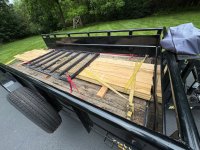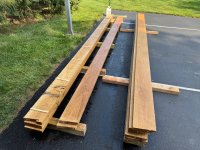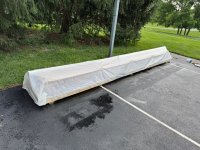2manyrocks
Super Member
- Joined
- Jul 28, 2007
- Messages
- 9,517
The metal on your trailer looks in amazingly good condition. White oak will be awesome.
Thanks. It's starting to rust and bubble in a few spots, and I'm debating on how to deal with that. Any place I have ever repaired via rattle can seems to not hold up, but I really hate breaking out the HVLP gear for spot repairs. Maybe I just need to do more and thicker coats when I rattle can it.The metal on your trailer looks in amazingly good condition. White oak will be awesome.




Yes, there's a gap down each long side, but I'm not convinced that's enough. I plan to add some stringers to the long top corners, attaching them to each end of the cross members supporting the pipe, just to gap the plastic off the oak a bit better. But if you have any advice on how to optimize ventillation, I'm all ears!Just asking...
Is there any airflow in and out of the "kiln".
I move about 60,000 pounds of oak per year, I know the wood better than most. White oak in particular takes about 3 years just to reach 18% moisture content, and our equillibrium moisture content (EMC) for white oak in this climate is around 15%. Did I mention I use a lot of white oak?There's no need to kiln dry oak for a trailer deck. I'd let it air dry for a week or two and then bolt it down. If you were making furniture, sure go the kiln dry route.
Flat sawn white oak 8" planks will usually shrink about 1/2" across their width between milling and EMC, depending on initial moisture, exact sawing orientation, etc.I don't know if it would make a difference, but you could remove the old trailer deck and use the trailer frame as a drying rack to get the oak further off the ground and away from ground moisture.
My experience with sawmill red oak used as siding is the width shrinks a surprising amount after it dries out. I haven't worked with white oak, but if white oak shrinks like that, I'd want it as dry as I could get it.
I've seen them, but can't imagine how I'd skid logs up into the trailer without a continous ramp.Have you considered two fold up ramps, that way they can stronger and heavy duty split folding but still be manageable.